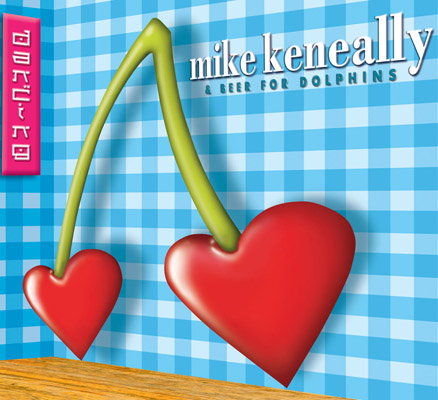Dancing
Mike Keneally & Beer For Dolphins
Released 2000
- Live In Japan
- Ankle Bracelet
- Poo-Tee-Weet?
- Backwards Deb
- We’ll Be Right Back
- Joe
- Pretty Enough For Girls
- Taster
- Dancing
- Selfish Otter
- Only Mondays
- Lhai Sal
- The Mystery Music
- The Brown Triangles
- MM
- I Was Not Ready For You
- Ragged Ass
- Skull Bubbles
- Friends And Family
- Kedgeree
Mike Keneally & Beer For Dolphins
DANCING
“When you talk about something — unless you’re a poet — a big thing becomes smaller.”
–David Lynch
Nonetheless, here’s a big bunch of dancing about a big bunch of architecture called Dancing.
Mike Keneally vocals, guitar and keys
Bryan Beller bass
Marc Ziegenhagen keys
Jason Harrison Smith drums
Tricia Williams percussion
Rick Musallam guitar and vocals
Evan Francis alto sax and flute
Chris Opperman trumpet
Produced by Mike Keneally
Executive producer — Scott Chatfield
Engineered by Mike Harris at Signature Sound
And by Jeff Forrest and MK at Double Time
Edited by Scott Chatfield and MK
Mastered by John Golden
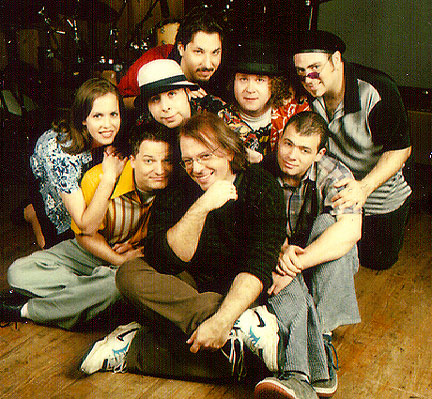
Mike’s comments (2013):
Dancing is a document of the superb eight-piece Beer For Dolphins I was fortunate to be leading at the time, with the most luxurious live sound combinations I’d ever had access to. Very much of what is heard on the album was recorded live in the studio, with vocals and some very minimal additional instrumentation overdubbed afterward. To be able to pull off such complex arrangements live in the studio, and such a large quantity of them in a short time, was miraculous for me, and everyone in the band did absolutely heroic work.
At the same time, Dancing was written and recorded at a time when I was a very different person than I am now, and one whom, when I look back, I don’t care for too much. I won’t get into gory details but I think I was suffering from a messiah complex and midlife crisis at the same time. Dangerous combination. I was making changes in my life without heeding the feelings of others, but I felt that all my actions were shepherded and approved of by cosmic forces. (As Frank Zappa would have said, “phewwwwww.”) In a year’s time I would settle down a lot and produce Wooden Smoke, by which time I’d achieved some calmness, but by my standards Dancing documents me at my most insufferable – so it’s a bit hard for me to listen to it.
Having said THAT, I acknowledge that my issues with the album are entirely personal, and that it’s a lot of people’s favorite album I’ve done; I’ve often seen people online recommending it as a starting point for newcomers to my music. It IS a strong bunch of material, and the arrangements were painstakingly arrived at and really nicely performed. I listened to all 80 minutes of it yesterday (it was a struggle to cut it down to even that length in order to fit it on one CD) and I hear in it so many producing choices that I wouldn’t make now; if I went into the studio tomorrow with the same material and the same group of players I think I’d make something a lot stronger – but I shouldn’t trash talk the album. It has brought a lot of people a lot of pleasure and I’m happy about that.
It was certainly a challenge I enjoyed to write all of these arrangements for the eight-piece band. The majority of them were written while I was on the road with Steve Vai; I was scribbling on manuscript paper anytime I had a spare moment. I was very excited, extremely driven to write and record these arrangements. (It was this pile of manuscript paper that Co de Kloet saw during the Vai European tour, and which prompted him to ask me to arrange Nonkertompf for an eleven-piece ensemble at the 2001 Marathon Festival in Groningen – which ultimately led to the orchestral commission for The Universe Will Provide. For that reason alone I’m glad Dancing happened!)
Then the players in Beer For Dolphins convened for three days of hardcore rehearsal and communal living at Chatfield Manor prior to recording the album. This rehearsal period became known as Kamp Keneally and was heavily video-documented (video I haven’t seen in years and am frankly terrified to look at now, for fear of being confronted again by that particular version of me – but I do remember it as an idyllic three days).
I wrote A LOT about the songs on this album when it came out…maybe it’s best for me to get my revisionist 2013 self out of the way and let the year-2000 me have his say again!
Read wildly extensive notes from the year 2000 (and see shots from the recording sessions) here:
LIVE IN JAPAN
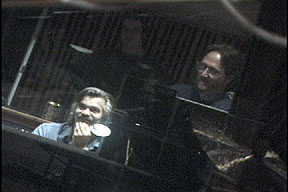
This song was inspired by a Chicago album called “Live In Japan.” I saw it over there on the shelf and a voice in my head pronounced “live” the other way. I laughed, and a few seconds later the chorus melody and some of the lyrics arrived (when bits of songs arrive this way, I don’t really consider myself as having “written” them — they just show up). I scrawled it out and for a few months the song consisted of the lines “live in Japan, I’ll say that I don’t care, I promise to go there in a van and live in Japan.” Some of those lyrics got adjusted later, on the road (a LOT of the songs/arrangements on the album were worked out during the ‘99/’00 Vai World Tour), but the van stayed. It snuck in there because it rhymes with Japan, and it also ties in with a song from “Elephants Walking Under God” (circa 1984) called “Transported In The Night,” which had a chorus that went: “We need a van! We need a van!” Back then, it referred to the fact that my brother Marty and I wanted to buy a cheap van so that we could get all of our gear to all of the gigs we weren’t actually booking.
Even when “Live In Japan” was nothing more than half a chorus, I thought it possessed the ineffable aura of an album opener. As the song’s different themes and variations piled up and the lyrics solidified, I saw that, even though the lyrics were a nice take on the desire to alter the course of one’s life in a fundamental way, the song was pretty darn corny. At this point a writer needs to make a major decision: do I allow this song to be as goofy as it wants to be? Once I decided to stick that “doot doot doot” melody at the end, my commitment to goofiness was complete (the melody arrived one during the Vai tour — I was standing in the upstairs sleeping compartment of the bus we had for the European leg and it showed up, complete). The end of the song is simultaneously a tribute to Blood Sweat & Tears’ “Spinning Wheel” and XTC’s “Helicopter,” possibly an unprecedented occurrence.
The band’s first exposure to this, and eight of the other songs on the album, came with a batch (perhaps they were a clutch) of demos which I recorded very quickly, with Scott Chatfield engineering, at Scott’s home. We burned the demos onto CD and shot them off to the band, using the United States Postal System. The band played through all nine of these songs for the first time during Kamp Keneally, the three-day rehearsal period held at Chatfield Manor just prior to the album recording. It’s sweet how much of this music — over half of the album – was brand new to the band, and remarkable how quickly and effectively they took the material to heart and made it their own. “Live In Japan” is a difficult song for an eight-piece band to play well; learning the parts wasn’t a problem, but staying out of each others’ way took a while.
“Japan” was the first thing we recorded for the album, having made the decision to record the songs according to the (what turned out to be tentative*) running order I’d devised for the album. When we heard the playback of our first attempt at a live basic track, it was a revelation. I’d never before recorded more than three players at a time for one of my albums, and it was a rush to hear this rich, naturally orchestral sound coming out of the speakers without any overdubs or board tweakage. That first playback of the session was a real nice moment.
The mix on this one took a lot of doing (and doing and doing – a mix that sounds perfect prior to dinner can sound completely unsatisfactory with a belly full of Rubio’s). It took about thirteen hours to put this puppy to bed, the longest single mix of the album. We strove to avoid messiness, overcompression, waxy frequency buildup etc. All these things are subjective of course — but to my ears the final mix is extremely exhilarating and listenable, with all the elements folding into one another nicely. Thank God for automation!
That’s me and Scott Chatfield doing the falsetto “Will you think of me when I’m gone?” part in the middle. It took a while to nail the gang vocals on the choruses, maybe two and a half hours. Thanks to Scott for his suggestion, after many failed attempts to find the right vocal approach, to slow the tape down so that the vocals would sound sped up on playback. It did the trick perfectly.
I think it was while we were mixing this song that J. Warner came to me in the studio and said “I finally figured out what this song sounds like. It sounds like falling in love.”
*Here’s the tentative album running order to which I referred during the sessions. This is largely the order in which we recorded the songs, with several exceptions due to special instrumentation, mic’ing requirements or other considerations:
- Live in Japan
- We’ll Be Right Back
- Backwards Deb
- Poo-Tee-Weet?
- A Very Special Episode of “Lonely Man”
- Ankle Bracelet
- Pretty Enough For Girls
- Taster
- Dancing
- “Drug Opera”:
- Selfish Otter
- Only Mondays
- Lhai Sal
- Delicious Shoes
- The Mystery Music
- I Was Not Ready For You
- Ragged Ass
- Joe
- Friends And Family
- Skull Bubbles
- The Endings Of Things
- Kedgeree
“A Very Special Episode of ‘Lonely Man’” was the original title of “Lonely Man” (this song can be heard in a solo rendition on “Dancing With Myself,” the second disc in the special limited edition of “Dancing”). “Delicious Shoes” was not recorded; “Lonely Man” and “The Endings Of Things” were, although neither one was utterly completed (they’re close though). “Lonely” and “Endings” were cut from the album due to time constraints, and “Delicious” abandoned because it was a little too stupid for this album. “MM” was part of “The Mystery Music” and had not yet been assigned its own title. The two interludes in “Lhai Sal” (called, respectively, “Stravinsky Section” and “Helsinki Bap”) were recorded separately from the rest of the song; Scott Chatfield and I edited them in later.
Also, if you’re interested, here’s the running order of the nine-song home demo CD Scott and I distributed to the band members prior to rehearsal:
Live in Japan/We’ll Be Right Back/A Very Special Episode of “Lonely Man”/Ankle Bracelet/Dancing/Lhai Sal/I Was Not Ready For You/Friends And Family/Skull Bubbles
A further note: the vocal-and-piano demo of “I Was Not Ready For You” included on the demo CD was actually recorded at Signature during the “Nonkertompf” piano sessions.
ANKLE BRACELET
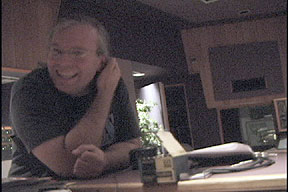 During the Australian portion of the Vai tour in early 2000 we took a day off on Rottnest Island. I didn’t feel like snorkeling, so I stalked the island and haunted its saloon, with lyric book in hand. A productive afternoon resulted in lyrics for “Ankle Bracelet,” “Skull Bubbles” and “I Am Of Two Hearts” (no music was ever written for that last song, but its title suggested the album cover design to atticus wolrab). I hijacked a jukebox in the saloon, to the glaring discomfort of a few sullen regulars; one of the songs I played was “Bittersweet Symphony” by the Verve, and some of its DNA leaked into “Ankle Bracelet” that day. I’d be silly not to acknowledge “Airbag” by Radiohead as well. Musically this song screams 1998.
During the Australian portion of the Vai tour in early 2000 we took a day off on Rottnest Island. I didn’t feel like snorkeling, so I stalked the island and haunted its saloon, with lyric book in hand. A productive afternoon resulted in lyrics for “Ankle Bracelet,” “Skull Bubbles” and “I Am Of Two Hearts” (no music was ever written for that last song, but its title suggested the album cover design to atticus wolrab). I hijacked a jukebox in the saloon, to the glaring discomfort of a few sullen regulars; one of the songs I played was “Bittersweet Symphony” by the Verve, and some of its DNA leaked into “Ankle Bracelet” that day. I’d be silly not to acknowledge “Airbag” by Radiohead as well. Musically this song screams 1998.
A few people wish the drums in this song sounded more like Stone Temple Pilots, but — and no offense meant, really – not sounding like Stone Temple Pilots has never been a problem for me. I wasn’t necessarily going after a standard modern huge squotchy drum sound, I just wanted an overall mix which was a big noisy indefinable glorious mess that felt good. Far as I’m concerned, I got one, and it really does sound best when played loudly. The vocals are intentionally buried in the mix – I wanted them to be a part of the mess rather than riding on top of it — but they seem to get a little louder and more distinct every time you hear the song (that’s how it feels to me anyway).
This seems to be the song that has provoked the widest range of opinion amongst listeners. It’s a lot more direct than most things I’ve written, and I struggled to keep it that way — I kept challenging myself to keep it simple and not throw in too many disparate sections. I also wanted it to be something that would be a lot of fun to play live, and it is. If you enjoy the song, I appreciate it!
POO-TEE-WEET?
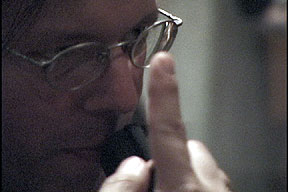 A while ago we were preparing to do a live radio broadcast for a show called “The Lounge” on San Diego public radio station KPBS. I got the idea that I wanted to perform a couple of continuous suites of music on the program and — typical Keneally behavior – additionally decided that I needed to spring some brand new music on the band a couple of hours before the broadcast. I wanted something with very dense, clustered vocal harmonies to begin our performance; direly in need of lyrics, I leafed through an old lyric book of mine (it contains the handwritten lyrics for “Performing Miracles,” “My Dilemma,” a lot of “Sluggo!” tunes and some unreleased stuff like “Donut Dunked In Champagne,” the title of which got altered and used in “Ankle Bracelet”). The words that eventually became “Poo-Tee-Weet?” popped out at me while thumbing through the book. They were part of a longer song, also called “Poo-Tee-Weet?,” about a daughter’s attempt to turn her father on to the novel “Slaughterhouse Five” in the vain hope that it would move him in the way it had moved her. The song wasn’t good, but I liked the title (Vonnegut’s transliteration of a bird song) and these few lyrics had an ambiguity which I knew would be valuable for the vocal texture I was trying to create. I happened to be standing next to the piano and the chords tumbled out quickly — it utterly wrote itself. At the rehearsal for the radio show we quickly learned the piece and debuted it on the radio that night — it was the first piece of music we performed on the show. It turned out good!
A while ago we were preparing to do a live radio broadcast for a show called “The Lounge” on San Diego public radio station KPBS. I got the idea that I wanted to perform a couple of continuous suites of music on the program and — typical Keneally behavior – additionally decided that I needed to spring some brand new music on the band a couple of hours before the broadcast. I wanted something with very dense, clustered vocal harmonies to begin our performance; direly in need of lyrics, I leafed through an old lyric book of mine (it contains the handwritten lyrics for “Performing Miracles,” “My Dilemma,” a lot of “Sluggo!” tunes and some unreleased stuff like “Donut Dunked In Champagne,” the title of which got altered and used in “Ankle Bracelet”). The words that eventually became “Poo-Tee-Weet?” popped out at me while thumbing through the book. They were part of a longer song, also called “Poo-Tee-Weet?,” about a daughter’s attempt to turn her father on to the novel “Slaughterhouse Five” in the vain hope that it would move him in the way it had moved her. The song wasn’t good, but I liked the title (Vonnegut’s transliteration of a bird song) and these few lyrics had an ambiguity which I knew would be valuable for the vocal texture I was trying to create. I happened to be standing next to the piano and the chords tumbled out quickly — it utterly wrote itself. At the rehearsal for the radio show we quickly learned the piece and debuted it on the radio that night — it was the first piece of music we performed on the show. It turned out good!
For the “Dancing” version, the vocals were tracked individually, with each of the four vocalists (me, Rick Musallam, Bob Tedde and Mark DeCerbo) triple-tracked. It was great fun hearing the chords build up and getting richer and richer. “Because” from “Abbey Road” was a major touchstone here.
BACKWARDS DEB
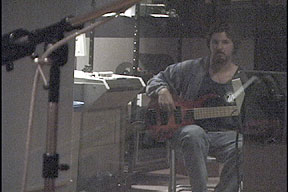 We started playing this song live during the 1998 “We’re Not Here To Help” tour, and a lot of people got used to the live arrangement through repeated exposure to fan-distributed tapes and CDs of that tour and the 1999 Baked Potato shows. In the studio we tracked this one just like the live version, I swear, and I hadn’t switched the perspective of the lyrics to first person yet. It was the second song we recorded (even though “We’ll Be Right Back” was the second song in the prospective running order, it was suggested that we do this one before that one, due to the band’s familiarity with “Deb”) and, later, the first song we mixed. It was a good, solid representation of a good, solid tour-like performance of the song. After we’d done a few more mixes and Mike Harris and I started to be a deadly efficient mixing mechanism, we listened back to the first few mixes we’d done and “Deb” bored the tar out of me. It came extremely close to not making it on the album as a result of that mix. The “Backwards Deb” vs. “Lonely Man” debate raged for several days.
We started playing this song live during the 1998 “We’re Not Here To Help” tour, and a lot of people got used to the live arrangement through repeated exposure to fan-distributed tapes and CDs of that tour and the 1999 Baked Potato shows. In the studio we tracked this one just like the live version, I swear, and I hadn’t switched the perspective of the lyrics to first person yet. It was the second song we recorded (even though “We’ll Be Right Back” was the second song in the prospective running order, it was suggested that we do this one before that one, due to the band’s familiarity with “Deb”) and, later, the first song we mixed. It was a good, solid representation of a good, solid tour-like performance of the song. After we’d done a few more mixes and Mike Harris and I started to be a deadly efficient mixing mechanism, we listened back to the first few mixes we’d done and “Deb” bored the tar out of me. It came extremely close to not making it on the album as a result of that mix. The “Backwards Deb” vs. “Lonely Man” debate raged for several days.
The night before the final day of mixes, with me pretty well consigned to the notion of no “Deb” on the album, J took me out to his car during a break and played me a few tracks off “The Marshall Mathers LP” by Eminem. I was blown out by the power of the production, in particular the huge, heart-stopping gaps between beats. I have some issues regarding Eminem’s success, but the few things I’ve heard from his new album are chilling and fascinating.
I fell into a spell while lying awake that night and got the urge to gate out all the cymbals in “Backwards Deb,” “Peter Gabriel III” style, and leave as many shocking holes in the mix as I could. I got pictures in my head of instruments that could be muted in certain sections to achieve stark, disorienting effects, and which parts of the song I wanted to edit out altogether. The next day in the studio it took a while to bring these concepts to fruition. Some of what I was doing in the early part of the day was phenomenally wrong-headed, and everyone seemed a little curious about the location of my senses. Over a nine-hour mixing/overdub session I honed my ideas, and everyone gradually came to understand what I was hearing in my head. We ended up with a piece of music which packs a physical wallop and conveys a claustrophobic atmosphere which, when combined with me singing the lyrics in the first person (onstage it had been a finger-pointing song), finally made the song feel right to me. And “Lonely Man” gets to stay lonely a little while longer, although at least you get to hear a solo version of it on “Dancing With Myself” (if you act now).
By the way, I heard the original mix of “Deb” again a few days ago and it sounded good.
WE’LL BE RIGHT BACK
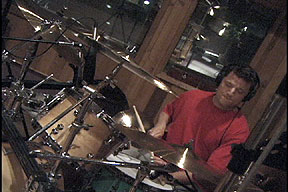 The seed of this song was a little rotating 3/4 guitar part I wrote almost two years ago, which became my rhythm guitar part during the choruses (“tend your garden”). That was around for the better part of a year before anything else got put in the song, and I remember working it into some acoustic improvs at the solo shows I did in Japan and Australia during the Vai tour. On the road I finally wrote lyrics and the rest of the music. Shortly before the BFD performance on KPBS’ “The Lounge” I wrote an instrumental intro which we played on that program, and at the Baked Potato soon thereafter.
The seed of this song was a little rotating 3/4 guitar part I wrote almost two years ago, which became my rhythm guitar part during the choruses (“tend your garden”). That was around for the better part of a year before anything else got put in the song, and I remember working it into some acoustic improvs at the solo shows I did in Japan and Australia during the Vai tour. On the road I finally wrote lyrics and the rest of the music. Shortly before the BFD performance on KPBS’ “The Lounge” I wrote an instrumental intro which we played on that program, and at the Baked Potato soon thereafter.
The lyrics started out as a childhood rumination: a memory of an impressionistic still photo which I recall being shown in and out of the commercial breaks on the (I think) Channel 2 Late Late Movie when I was a kid in Long Island. It might have been a photorealistic painting, or maybe my memory’s playing tricks — I could have dreamed it. In my memory, the photo shows a clutch of darkened homes on a hill with TV lights glowing in the windows, the supposition being that all was quiet and still in the house except for the images the little people inside were watching on Channel 2. It was very peaceful and dreamy and I had the enviable position of living in a house just as safe and secure as the ones I imagined those houses to be. Still, I fantasized about being able to go into those homes, just to bask in whatever specific kind of peacefulness resided therein. And this would occupy my last waking thoughts as I lay next to my Dad as he watched the Late Late Movie.
Well, I couldn’t write lyrics about that, although I tried. I kept the title because I liked it, and later wrote three pages of small-print words about how badly people behave. Gradually I took out most of the especially churlish, reactionary, petulant lyrics which I always seem to write when I get too excited about my own anger (cf. “Vent”), and what remained is what you hear. The mispronunciation of “hubris” was an attempt to linguistically link misplaced Caucasian pride (“white man hubris”) to the concept of “debris” — probably too thin a stretch. It also rhymes with “military.”
This is another song which the band first became acquainted with at Kamp Keneally (save for that intro). This fell together so nicely in rehearsal, and despite the fact that it’s one of the more unusual tunes structurally on the album it was breezy to record as well. Bryan’s bass harmonics are like fairy dust on the choruses, and the way the band sounds on the verses is so nice: a wide open, spacious rock and roll groove unlike any I’ve been able to achieve on record before, my little Neil Young fantasy come true. The guitar solo on the Pink Floyd section at the end (so named because the airy groove and chord structure were inspired by early 70’s Floyd) is something I am really happy about. For me, the perfect way to end “side one.”
JOE
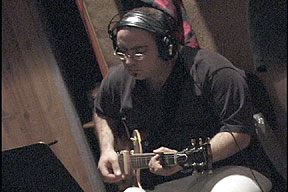 And, for me, the Rhodes chords at the beginning of “Joe” are the perfect way to begin “side two.” When I first played this to the band at rehearsal a bunch of months ago, Bryan said, once he determined that it was indeed about our dear friend Joe Travers, “Joe’s going to love this…it sounds like a whole bunch of seventies stuff he’s in love with: Todd Rundgren, Stevie Wonder, Chicago…” I hadn’t thought of it that way but he’s right, and I’m glad that’s the way it turned out. To me this song feels like a night at Joe’s place listening to music and relaxing, with nowhere to go anytime soon.
And, for me, the Rhodes chords at the beginning of “Joe” are the perfect way to begin “side two.” When I first played this to the band at rehearsal a bunch of months ago, Bryan said, once he determined that it was indeed about our dear friend Joe Travers, “Joe’s going to love this…it sounds like a whole bunch of seventies stuff he’s in love with: Todd Rundgren, Stevie Wonder, Chicago…” I hadn’t thought of it that way but he’s right, and I’m glad that’s the way it turned out. To me this song feels like a night at Joe’s place listening to music and relaxing, with nowhere to go anytime soon.
Things I especially love about this song are how it feels to play the Rhodes and sing on it, the little bubbling marimba parts, Evan’s amazing sax solo at the end, and Rick’s spectacularly soulful guitar. That line at the very end of the song slid out of Rick’s fingers with no prior discussion, and it was absolutely the perfect ending. It reminded me of the little seven-note tag Michael Omartian improvised at the end of the piano coda on “Throw Back The Little Ones” from “Katy Lied”…Becker and Fagen didn’t write that line, but they knew it was perfect — they even ended the album with it. The fact that this song feels a little Dan-ish made Rick’s unexpected gift at the end all the more appropriate.
It took me several goes to land a vocal performance which cuddled into the rest of the track just right. I recorded several tries at Double Time, where I spent a great week with Jeff Forrest doing vocals and overdubs following the basic tracks at Signature, but there was some agitation in my system which didn’t allow me to nail it. During the week of mixdown and final overdubs at Signature, I ended up re-doing several lead vocals I thought I had completed at Double Time, of which “Joe” was one — it took me a bit of time to get fully relaxed and confident with it. I’m so happy with everything about this song, it knocks me out.
The word “motherfucker” in this song came under some amusing scrutiny. At the time that this song was recorded, “The Endings Of Things” (which contains the word “fucking”) was still in the running for inclusion on the album. “We’ll Be Right Back” still had the word “fucking” in the lyrics (you can hear it, to the song’s detriment I now feel, on “Dancing With Myself”). I didn’t want three fucks on the album; this may seem awfully quaint nowadays, but when I was a kid, “fuck” was still a pretty powerful word. On this album I wanted to return some of this word’s rightful impact and declared a moratorium on multiple usage. Losing the one in “We’ll Be Right Back” wasn’t a struggle, as I came to view its usage therein as unnecessary. The one in “The Endings Of Things” is crucial, but once that song was out of the running, it ceased to be an issue. I’m thrilled that “Joe” got the nod, because, as several people have been kind enough to point out, it’s a very loving usage. We did do a virtually identical mix with “my brother” instead of “motherfucker” if we ever need it.
PRETTY ENOUGH FOR GIRLS
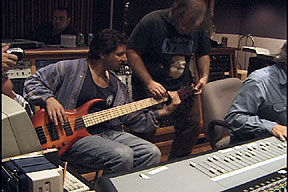 This is probably the song most likely to elicit audible disenchantment from anyone who was especially fond of the earlier live arrangement. It’s never my intention to disappoint, of course. The changes in this song happened because I was excited about trying them, and I felt that the song’s place in the album sequence, especially once I realized it was coming after “Joe,” required them. But I fully sympathize with anyone who hankers for the original treatment, and part of me agrees with them.
This is probably the song most likely to elicit audible disenchantment from anyone who was especially fond of the earlier live arrangement. It’s never my intention to disappoint, of course. The changes in this song happened because I was excited about trying them, and I felt that the song’s place in the album sequence, especially once I realized it was coming after “Joe,” required them. But I fully sympathize with anyone who hankers for the original treatment, and part of me agrees with them.
It was always an elaborate piece, but on stage in 1998 (with four band members as opposed to eight) it was a lot spacier. As the band began expanding, I decided to make this song a canvas for our new line-up’s possibilities. Part of this was the result of hearing tour tapes from ‘98, where I sometimes felt that the song’s pace was languid to the point of torpor; occasionally it would have an aimless quality. I had a feeling that simply recording the live arrangement in the studio would be doing the song an injustice. That was when I started dropping hints to people, suggesting they shouldn’t become too accustomed to the arrangements they’d heard us playing live.
So I set about arranging this sucker. I spent a lot of time on the Vai tour scribbling notes down, and ended up subtracting maybe half of them during rehearsals and mixdown. (Most of the horn and percussion arrangements on this album were done in hotel rooms without an instrument at hand. I would occasionally get over-excited with the sounds I was imagining and write way too many notes down – luckily I had no qualms later about axing a part, even something I’d spent hours writing, if it didn’t work in the song). I wanted “Pretty Enough” to be a big friendly episodic funny tasty thing, a rich, tangy blend of Parmesan and Monterey Jack cheeses mixed with big pieces of savory grilled artichoke hearts. I went a bit Broadway with it actually: the final “sky home safe moan sigh” after the “Crow” section feels to me like the entire cast has taken to the stage. I’m thrilled with the re-arranged intro; to me it sounds like the sun coming up, with Oppy’s trumpet as the rooster. I also like the vocal echo in the verses, and the MK guitar duet toward the end (it’s surprisingly conversational, given that the two tracks were separate solo attempts that we listened to at the same time just for fun, and ended up deciding to use them both). It should go without saying that everyone in the band did a gorgeous job on this fairly demanding song.
Probably the most controversial change in the song was the removal of one entire section, an instrumental recap of the chord structure of the verses played at about octuple speed, in faux-Gentle Giant contrapuntal style. Sometimes it worked on stage, but conceptually it didn’t advance the “plot” of the song for me, although it was often fun to play.
So I put “The Crow Dream” in there instead. I had the crow dream on the bus during the Vai tour; my own laughter woke me up, and with eyes still blurred from sleep I scribbled down the description of the dream which I recite in the song. My slowed-down voice here is a nod to Todd and “No. 1 Lowest Common Denominator.” Regarding the music behind the crow: a couple of decades ago I had a dream about listening to Michael Mantler’s “Jazz Composer’s Orchestra” album and hearing some impossibly beautiful flute music. I bought the album, half expecting to actually hear those flutes, and didn’t; ever since then I’ve wanted to try and recreate that sound. The “Crow” background music was my first attempt to capture it. (No, I didn’t quite nail it, but I like what I ended up with just fine.) I don’t regret losing the section that was axed, but I felt sad when I learned that it was Ron Spiegelhalter’s favorite 13 seconds of Keneally music (it’s actually more like nine seconds, but the “13 seconds” quote has become deathless). As any regular at alt.music.mike-keneally well knows, Ron is a superb individual and making him get a sad face is the fourth from last thing I would ever want to do. Happy ending: the missing part still lives, in acoustic form, on “Dancing With Myself,” and in its original form on countless MK/BFD unofficial live recordings.
Shortly after the album mix was done, BFD snuck into Denver to play at a private party. We played this song the old way and I enjoyed it greatly, and found myself wondering if I’d gone overboard on the album. Since the album arrangement is really difficult to pull off on stage anyway, I think it’s likely that the original arrangement will still be heard quite a bit.
TASTER
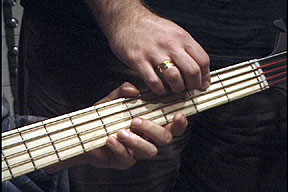 This was the scariest song on the album for me. It wasn’t one where just a decent replication of the live arrangement would do, even though I knew I didn’t want to add much new instrumentation. This song’s all about catching a vibe, which obviously can’t always be achieved on demand. Sometimes this song would kill on stage, and sometimes it would just sit there and shudder a bit.
This was the scariest song on the album for me. It wasn’t one where just a decent replication of the live arrangement would do, even though I knew I didn’t want to add much new instrumentation. This song’s all about catching a vibe, which obviously can’t always be achieved on demand. Sometimes this song would kill on stage, and sometimes it would just sit there and shudder a bit.
I needn’t have worried; by this point in the sessions, the band was deep into a very good groove — hardly anything we were doing required more than two takes, and everything sounded fantastic. This one is a second take performance. For me it’s the best the band has ever played the song. I’m glad I got the guitar part in one take; I wasn’t interested in trying to piece together the “perfect” performance. There are a lot of little finger slips and frailties audible in the guitar performance, but you know I don’t care about that stuff. I’m 100% happy with what we captured in this recording.
Doing the mix on this was fun. I asked Mike Harris to give the drums an overall more high-end EQ than they’d had on “Pretty Enough.” This gave us a nice change of texture at the segue leading into “Taster,” and cleared out most of the bottom region of the mix for Bryan to inhabit. The bass sounds just huge. I love it. I also like the delays on the guitar, and the odd, ghostly sound of Marc’s volume-swelled Rhodes, a different sound than he’d ever used on the song before, which required him to approach the performance completely differently — he nailed it and it gives the song an eerie sheen. (You can see Eerie Sheen, the youngest and sassiest of the Sheen/Estevez acting dynasty, on the new Fox series “These Pants? What?”)
DANCING
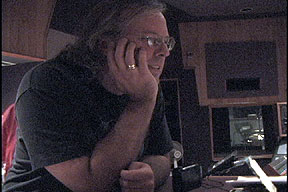 The acoustic guitar part was written in early ’98 and was originally called “Inkling.” The lyrics were going to be about someone who has an inkling, which turns out to be some sort of odd creature, but I never got anywhere good with that idea (it was a rip-off of Mad Magazine’s “Horrifying Cliches” anyway). Then it was going to be about a guy who hates either Oasis or Jimmy Buffet – I couldn’t decide which one. Later, in France with Vai with Eric Sardinas, there was an incident wherein Eric and his band, looking for something of local interest in a particularly remote French location, walked for about four miles (at the urging of a wicked cabbie) and found absolutely nothing. This suggested to me this song’s opening line: “no don’t go that way, there’s nothing there.” That line spawned a love song, the lyrics and melody of which seemed pre-determined by the guitar part. It all fell out. I knew the album was going to be called “Dancing” by this point and I was super happy to actually have a title song with lyrics – I never had one of those before! Yay to Jason, Bryan (that SOUND!), and Peggy for doing all the perfect things on this song. Peggy sounds so sweet on this. A special hey to Rick, who did otherworldly stuff with his E-bow and a slide whistle he found at Double Time (the same one I used on “Yep, Them Dolphins Is Smart, Alright,” I’m guessing). What you hear on the album, by the way, is a rough mix — I didn’t think we could improve on it (and we ran out of studio time before we could try).
The acoustic guitar part was written in early ’98 and was originally called “Inkling.” The lyrics were going to be about someone who has an inkling, which turns out to be some sort of odd creature, but I never got anywhere good with that idea (it was a rip-off of Mad Magazine’s “Horrifying Cliches” anyway). Then it was going to be about a guy who hates either Oasis or Jimmy Buffet – I couldn’t decide which one. Later, in France with Vai with Eric Sardinas, there was an incident wherein Eric and his band, looking for something of local interest in a particularly remote French location, walked for about four miles (at the urging of a wicked cabbie) and found absolutely nothing. This suggested to me this song’s opening line: “no don’t go that way, there’s nothing there.” That line spawned a love song, the lyrics and melody of which seemed pre-determined by the guitar part. It all fell out. I knew the album was going to be called “Dancing” by this point and I was super happy to actually have a title song with lyrics – I never had one of those before! Yay to Jason, Bryan (that SOUND!), and Peggy for doing all the perfect things on this song. Peggy sounds so sweet on this. A special hey to Rick, who did otherworldly stuff with his E-bow and a slide whistle he found at Double Time (the same one I used on “Yep, Them Dolphins Is Smart, Alright,” I’m guessing). What you hear on the album, by the way, is a rough mix — I didn’t think we could improve on it (and we ran out of studio time before we could try).
SELFISH OTTER
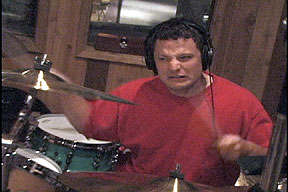 This is the first segment in what I was going to call “Drug Opera,” my umbrella title for the largely instrumental “side three” of the album. (My memory is hazy on this but I think “Drug Opera” is the name of a nightclub I saw while walking in Japan. It’s definitely the name of a building I encountered somewhere during the Vai tour.) This song was written at a Baked Potato soundcheck. When someone asked me what it was called, I glanced down at the set list for that night’s upcoming show and saw “Self ‘n’ Other” on there — I had no other choice. This is another rough mix — given the opportunity to do it again I would have loved to turn up Evan’s sax on the unison melody statements, and possibly mute out the weird tape noise at the beginning of the keyboard solo. But there is much wonderful stuff about this mix which I know we wouldn’t have been able to recapture. Rough mixes often sound great.
This is the first segment in what I was going to call “Drug Opera,” my umbrella title for the largely instrumental “side three” of the album. (My memory is hazy on this but I think “Drug Opera” is the name of a nightclub I saw while walking in Japan. It’s definitely the name of a building I encountered somewhere during the Vai tour.) This song was written at a Baked Potato soundcheck. When someone asked me what it was called, I glanced down at the set list for that night’s upcoming show and saw “Self ‘n’ Other” on there — I had no other choice. This is another rough mix — given the opportunity to do it again I would have loved to turn up Evan’s sax on the unison melody statements, and possibly mute out the weird tape noise at the beginning of the keyboard solo. But there is much wonderful stuff about this mix which I know we wouldn’t have been able to recapture. Rough mixes often sound great.
This song is a first and only take, and it’s edited down from eight minutes to four. There’s a lot of beautiful playing in the missing minutes, but the edits that we made were necessary not just for time constraints, but for the flow of the album as well. The full version would have made too big a lump in the middle of the album, and I wasn’t willing to sacrifice anything else to make way for it. Scott and I worked hard on the edits, and when we were done I was pretty sad to hear what we’d done to the song — the first three times I heard it. At that point I began to enjoy and appreciate the shorter version for what it was, and now I totally dig it. Even the eight-minute version has that ridiculously abrupt Teo Macero edit going into the separately-recorded coda (that coda, known on recent set lists as “Selfish Otter Drum Solo,” was renamed “Free At Last” by Jason at the Nonkerstock soundcheck). Thank you Marc Z. for that beautiful keyboard break — it’s so very right. The super-fast snatch of melody leading into the keyboard solo is the opening line from “Ornithology,” written by Benny Harris and Charlie Parker.
ONLY MONDAYS
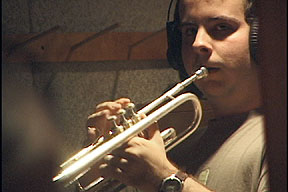 This song was largely dreamed. I awoke one morning, just a couple of weeks before the beginning of the album sessions, with most of the verse and chorus melody and a couple of lines of lyrics including the chorus. I also knew that it would be an answer song to The Carpenters’ “Rainy Days And Mondays” (Karen Carpenter being the “Karen” in the lyrics). The song was completed within about ten minutes of waking up. I thought I had already written everything for the album, but this song insisted on being included, and I’m grateful to it (I like it a lot). I love how the tape running out at the end of “Selfish Otter” segues into the beginning of this song. Everything about this song feels right to me.
This song was largely dreamed. I awoke one morning, just a couple of weeks before the beginning of the album sessions, with most of the verse and chorus melody and a couple of lines of lyrics including the chorus. I also knew that it would be an answer song to The Carpenters’ “Rainy Days And Mondays” (Karen Carpenter being the “Karen” in the lyrics). The song was completed within about ten minutes of waking up. I thought I had already written everything for the album, but this song insisted on being included, and I’m grateful to it (I like it a lot). I love how the tape running out at the end of “Selfish Otter” segues into the beginning of this song. Everything about this song feels right to me.
Thank you Oppy for making my Bacharach dreams come true in the trumpet solo! Tricia and Rick had a percussion party on this one. They really got into it. MZ got into doing the Moog bass too. Instrumentally this song is so distinct from the rest of the album. It’s the sherbet. Recording it was like eating sherbet too. Very pleasurable indeed. While the double-tracked lead vocals, I tried to expel the absolute minimum amount of air necessary to sing the notes in tune. That’s just about as delicately as I can sing, right there.
I didn’t realize until this song arrived just how much the “Drug Opera” needed it. Something about how this sits in between “Otter” and “Lhai Sal” gives me the same tingle of excitement as some of the segues on “A Wizard, A True Star” or “Todd” or — oh, this one definitely — the end of “Brown Shoes” into “America Drinks And Goes Home” on “Absolutely Free.” There’s nothing quite like a good segue.
LHAI SAL
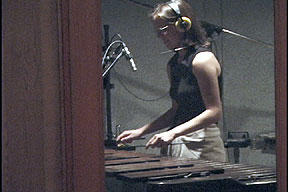 I’m not crazy about fast rock shuffles, especially ones with instrumental guitar melodies; it’s just so expected — but the album really needed a fast SOMETHING on it. I do enjoy the texture and the mix on this and feel that it serves the album well — it’s just what’s needed at this point in the sequence. And it’s fun. The way Bryan and Jason sound on the intro is so darned pleasurable to me. The main guitar riff was written in a dressing room somewhere in Eastern Europe, and was intended to be the background riff during the “we came from the bubble-o’s section” of “Live In Japan” before I decided not to clutter that section up so much. “Lhai Sal” (which is a conceptual companion piece to “Dhen Tin” from “hat.”) has lyrics which I opted not to record. They are the dumbest words I’ve ever written. Perhaps you will hear them one day. I don’t know. I…just…don’t…know.
I’m not crazy about fast rock shuffles, especially ones with instrumental guitar melodies; it’s just so expected — but the album really needed a fast SOMETHING on it. I do enjoy the texture and the mix on this and feel that it serves the album well — it’s just what’s needed at this point in the sequence. And it’s fun. The way Bryan and Jason sound on the intro is so darned pleasurable to me. The main guitar riff was written in a dressing room somewhere in Eastern Europe, and was intended to be the background riff during the “we came from the bubble-o’s section” of “Live In Japan” before I decided not to clutter that section up so much. “Lhai Sal” (which is a conceptual companion piece to “Dhen Tin” from “hat.”) has lyrics which I opted not to record. They are the dumbest words I’ve ever written. Perhaps you will hear them one day. I don’t know. I…just…don’t…know.
The middle interlude (referred to during recording as “Stravinsky Section”) was inspired by Stravinsky’s “A Wedding,” and it too has lyrics, and they too are very, very dumb. The middle section was always intended to be part of “Lhai Sal” (although I almost abandoned the idea — I’m glad that I changed my mind). Thanks so much to Tricia and Marc — now I can write music like this without having to play it myself! The sax/trumpet/marimba thing at the end was a separate piece, which Scott and I later made the decision to use as an ending. It’s a portion of the accompaniment score for a baritone guitar piece called “Helsinki Bap.” I unfortunately didn’t have the baritone guitar, a gift from my generous Finnish friend Sami, in my possession soon enough to record the complete “Bap,” unfortunately. I hope I remember it!
I think the live version of “Lhai Sal” on “Dancing With Myself” is extremely fun. Spiegelhalter says that it has replaced the missing “Pretty Enough” stuff as his favorite Keneally music ever — yay!
THE MYSTERY MUSIC
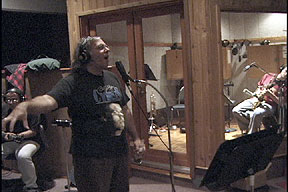 This melody showed up while I was shopping for jade at an open market in Taipei. I hightailed it back to the hotel to write it down before I forgot it, jotting it down in the lobby as I was waiting to be taken to the gig.
This melody showed up while I was shopping for jade at an open market in Taipei. I hightailed it back to the hotel to write it down before I forgot it, jotting it down in the lobby as I was waiting to be taken to the gig.
This song makes me smile. One of the things I enjoy best about it is that, except for an acoustic piano overdub on the first fast little lick, I don’t play anything at all. During the recording I just stood in the studio while everyone else played and grooved. Rick’s rhythm guitar on this song is a major component of its vibe. I love what he plays in the middle section. It took Jason a while to realize how little he needed to do in that section — just to coast for a while, with a few little accents here and there. Once Jason fell into it he nailed it perfectly — you can hear him stop and turn the snares off on his snare drum a couple of bars into the mid-section, which gets him that THWOKky sound. I think everyone was surprised that I wanted the arrangement to be so minimal on this tune, but what I had in mind was one of those sixties instrumental hits that would occasionally make it on the radio, eg. Hugh Masakela’s “Grazin’ In The Grass” — the sound of a bunch of obviously good musicians playing live in a good-quality recording studio, grooving along on a simple tune for a couple of minutes and making this freakin’ great sounding little record.
Huge kudos to Bryan for the neverending bass run at the end of the last verse. I LOVE that!
THE BROWN TRIANGLES
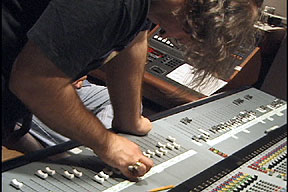 This song is an improvisation and as such should be credited to the band, which I was going to do in the liner notes but I forgot, which I regret. It happened after lunch one day; after scarfing I wandered out into the studio, where Oppy was getting stuff out of his system via the piano. I picked up the black SG (magic guitar!) and started to play with him, and I quickly got into a channeling mode — I went to a zone I’m occasionally able to visit where it’s possible for me to receive subconscious musical guidance via an arcane instantaneous spiritual notation method, and the guitar playing on this song was the beneficiary of this data. Hard to describe, and I’m being a little evasive on purpose (I don’t want to mess things up). The rest of the band filtered out into the studio while Oppy and I were playing, and Mike Harris, thank goodness, turned on the tape once we were all playing. This song, “Taster” and the solo on “We’ll Be Right Back” are my favorite guitar playing of mine on the album.
This song is an improvisation and as such should be credited to the band, which I was going to do in the liner notes but I forgot, which I regret. It happened after lunch one day; after scarfing I wandered out into the studio, where Oppy was getting stuff out of his system via the piano. I picked up the black SG (magic guitar!) and started to play with him, and I quickly got into a channeling mode — I went to a zone I’m occasionally able to visit where it’s possible for me to receive subconscious musical guidance via an arcane instantaneous spiritual notation method, and the guitar playing on this song was the beneficiary of this data. Hard to describe, and I’m being a little evasive on purpose (I don’t want to mess things up). The rest of the band filtered out into the studio while Oppy and I were playing, and Mike Harris, thank goodness, turned on the tape once we were all playing. This song, “Taster” and the solo on “We’ll Be Right Back” are my favorite guitar playing of mine on the album.
Actually only six of us are playing. While Mike Harris and I were investigating the multi-track master during the mixdown on this song, we found a fascinating scenario playing itself out on Tricia’s percussion track. Tricia had called Evan into her percussion booth and was questioning him relentlessly about the chart for “Mystery Music,” which we were scheduled to record next. You can hear in Evan’s voice how much he wants to leave the booth, get over to his microphone and start jamming with us, but Tricia won’t let him leave the room. All the while you can hear the rest of the band blasting away on “Brown Triangles” through the closed door of her booth. We tried to figure out a way to include this exchange on the album, but nothing really worked. It’s fun to hear though, especially when Tricia is singing the melody of “The Mystery Music,” utterly heedless of “Brown Triangles” leaking through the door. The girl is focused.
J. also has video footage, which he describes as pretty priceless, of this song being recorded, followed by me and the rest of the band going into the control room for the playback, during which I’m standing at the board headbanging and going nuts in my own little zone while the rest of the band hovers in the back of the room, well away from me, vaguely frightened. I remember that playback; Rick came to me and shook my hand afterward. Love you bro.
MM
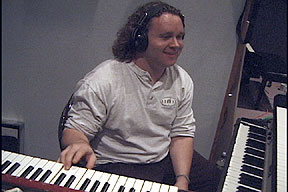 This is the coda to the complete score of “Mystery Music,” which actually goes through about four or five other sections which haven’t yet been recorded. The title is an abbreviation of “Mystery Music,” but I like its other two meanings as well. This was written without an instrument handy, so I’m glad it turned out to be something that sounds good on a piano, and I’m very grateful to Marc for his sensitive performance of it.
This is the coda to the complete score of “Mystery Music,” which actually goes through about four or five other sections which haven’t yet been recorded. The title is an abbreviation of “Mystery Music,” but I like its other two meanings as well. This was written without an instrument handy, so I’m glad it turned out to be something that sounds good on a piano, and I’m very grateful to Marc for his sensitive performance of it.
I WAS NOT READY FOR YOU
It wasn’t like I thought “I have to write a song about Kevin Gilbert.” In fact for a long time I didn’t think I should, simply because I hadn’t spent all that much time with him. Finally I realized that that was what I should write about. I wrote the words in my bunk on the Full Sail bus during the We’re Not Here To Help tour.
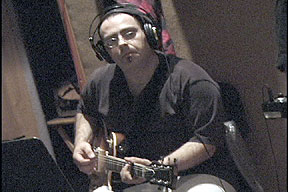 The music was written independently a good while later, not with the words in mind. One night while I was working on an arrangement for the piano solo album of Vai’s music which will come out someday, I needed a break from the relentless difficulty of the task at hand (MAN, that was a hard album to arrange. Hardest album I’ve ever made). To soothe my brain I found a nice synth patch, which combined organ and acoustic piano, and I just played a droning B natural for a long time, allowing the harmonics in the note to soak into me. This mellowed me out enough to start adding other notes, but I didn’t want to let go of the B, so I found a simple progression which would allow the B to stay on top: Ab minor, A2, Ab minor, G major. I liked the droniness and sad inevitability of that progression and the rest of the music fell into place in very short order, but I didn’t know yet that I was writing this song. The music and the lyrics sat around separately for months before, on a hunch, I tried putting them together.
The music was written independently a good while later, not with the words in mind. One night while I was working on an arrangement for the piano solo album of Vai’s music which will come out someday, I needed a break from the relentless difficulty of the task at hand (MAN, that was a hard album to arrange. Hardest album I’ve ever made). To soothe my brain I found a nice synth patch, which combined organ and acoustic piano, and I just played a droning B natural for a long time, allowing the harmonics in the note to soak into me. This mellowed me out enough to start adding other notes, but I didn’t want to let go of the B, so I found a simple progression which would allow the B to stay on top: Ab minor, A2, Ab minor, G major. I liked the droniness and sad inevitability of that progression and the rest of the music fell into place in very short order, but I didn’t know yet that I was writing this song. The music and the lyrics sat around separately for months before, on a hunch, I tried putting them together.
I’m very grateful to Jason for nailing the drum groove so well on this one. It established the mood perfectly and allowed everything else to sound good on top. Tricia’s finger cymbals have a lot to do with why the song feels “that way.” Rick’s guitar is phenomenal on this, possibly my favorite guitar playing on the album. His solos have the same timeless quality that I feel from the guitar solo in Carole King’s “It’s Too Late” — just perfect. Rick’s playing on both this song and “Joe” goes so deep, it’s scary.
RAGGED ASS
The very silly chorus melody of this song came while I was walking into the guest room — I think it was waiting there for me. I walked into the room and this music poured into my head, literally stopped me in my tracks. I got the green Strat on and figured it out, which then led to writing the guitar part in the verses. It was so much fun to play! I stalked around the house for a couple of hours playing it again and again. Then I wrote the intro, and I think the ostinato for the sax solo was written a couple of days later. Coming up with words took a while; the first couple of times we played it, when the six-piece BFD debuted in early ’99, we were doing it instrumentally. When the words finally started coming it was in a rush of nonsense — all the “ting-a-lang” stuff in the first verse. I tried like wham to find real words for that first verse but nothing I wrote felt right; somehow only those nonsense words conveyed the message of the song properly for me. But I was happy that Frang Tang and Molehead decided to pop up in there — I hadn’t heard from those guys in a while. The lyrics sum up a lot of the feelings that filled me during 1998, a year of tremendous change for me. The feelings do persist.
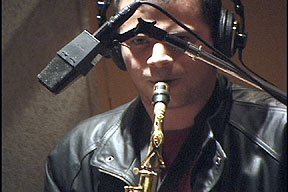 I spent a lot of time writing horn and percussion orchestration for this — crazy trumpet and marimba parts that skitter across the song. Oppy and Tricia played the parts beautifully, but when I tried to mix the song I found that I had well and truly over-written — the song was being submerged. Eventually, I muted out most of those parts, and quite a lot of the guitar, keys and sax tracks as well — I was really enjoying listening to just the bass and drums a lot of the time, which is why they’re the only instruments audible in the first verse. (You can still hear the trumpet and marimba on the choruses — Carl Stalling to the max.) Once I had decided to strip it down like that, there was plenty of room for vocal tomfoolery, and I had a lot of fun doing multiple voices, ad-libbing and reacting to my other voices on the tape. J has good video footage of this vocal session. The song, as it ended up, is a lot different than what it had previously been on stage, but I think it conveys the feeling in the lyrics a lot more interestingly than the more conventional live performances of it were able to.
I spent a lot of time writing horn and percussion orchestration for this — crazy trumpet and marimba parts that skitter across the song. Oppy and Tricia played the parts beautifully, but when I tried to mix the song I found that I had well and truly over-written — the song was being submerged. Eventually, I muted out most of those parts, and quite a lot of the guitar, keys and sax tracks as well — I was really enjoying listening to just the bass and drums a lot of the time, which is why they’re the only instruments audible in the first verse. (You can still hear the trumpet and marimba on the choruses — Carl Stalling to the max.) Once I had decided to strip it down like that, there was plenty of room for vocal tomfoolery, and I had a lot of fun doing multiple voices, ad-libbing and reacting to my other voices on the tape. J has good video footage of this vocal session. The song, as it ended up, is a lot different than what it had previously been on stage, but I think it conveys the feeling in the lyrics a lot more interestingly than the more conventional live performances of it were able to.
It was Evan who suggested that the repeated ostinato during the sax solo should travel chromatically down in half steps twice, then back up a whole step to the original key. If you listen to live tapes of the song from 1999 the ostinato stays in A throughout. Evan’s suggestion was fantastic, and it helped inspire him to a genius solo. Need I say how grateful I am to have Evan in this band? Need I or no, say it I do. Good sentence! Oh, Beller is king on this song. Along with Evan. Bryan and Evan are co-kings. Jason is kings on this, too, hey — just listen to what he’s doing during the sax solo. Good drumming! Yay for all the kings and queen of BFD!
SKULL BUBBLES
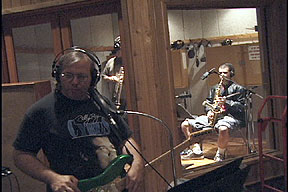 This song pretty much lays it on the line about some trying times over the last couple of years. It’s good to have gotten this song out of it. The lyrics were written on Rottnest Island, and the music written backstage at a really grimy nightclub in Hamburg.
This song pretty much lays it on the line about some trying times over the last couple of years. It’s good to have gotten this song out of it. The lyrics were written on Rottnest Island, and the music written backstage at a really grimy nightclub in Hamburg.
We nailed a great version of this one (slower than it is on the album) the very first time we played it at Chatfield Manor during rehearsals. There’s a good sounding DAT room recording of it. The album version, like “Selfish Otter,” is edited down from a much longer take. It’s virtually live — only acoustic guitar and vocals were added. Again, like “Otter,” the shorter take is the right one for the album, but the full version has a lot to recommend it.
Secret thing: the chord movement behind “When I was seven years of age” has led to that part being referred to by the band as “the Eddie Money section,” thanks to its resemblance to the chorus of “Baby Hold On To Me.” Oppy is channeling Sal Marquez throughout the track. Tricia is the vibra-slap queen. Pay special attention to what Marc is doing on Rhodes next time you listen — it’s cool. Bryan Beller is my hero. Evan, Rick and Jason rock with the force of seventeen stallions as well. I got a good band!
(Secret thing: 95% of the time I type the word “Evan,” I type “Even” first and have to go back and correct it.)
FRIENDS AND FAMILY
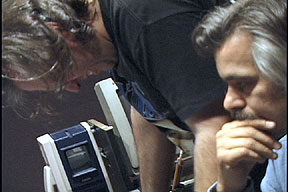 Here’s a bunch of facts: The music for this was written two years before the recording – I wrote the music for this, “Lonely Man,” “Backwards Deb,” “Pretty Enough For Girls” and “Taster” all around the same time in early ’98 and recorded 8-channel cassette home demos of them. None of them had lyrics yet. The original working title for this song was “Friend 2.0” because it was kind of inspired by “Friends” by the Beach Boys. “Lonely Man” was originally called “Backwards Deb,” because the main piano figure sounded a little like a song I wrote in high school called “Debi,” played backwards-ish. Later I changed the working title of “Lonely Man” to “Young,” because the piano style sort of reminded me of the opening and closing songs on “Sleeps With Angels” by Neil Young, and the name “Backwards Deb” was adopted by the song which ended up being “Backwards Deb” (and which ended up being an appropriate title when I was finally ready to write the lyrics). While I was in the final stages of preparing material for “Dancing,” “Friend 2.0” got renamed “Friends and Family,” which again proved more than appropriate once I got around to writing this song’s very few lyrics. (Solo piano instrumental versions of “Lonely Man,” “Friend 2.0” and an improvisation called “haraS Me” were recorded at Signature in 1998. At that point “Friends And Family” contained themes which later formed sections of “Clumpy Clumpy O” from “Nonkertompf” – in fact the piano on the coda of “Clumpy” was excerpted from this 1998 recording of “Friend 2.0.”)
Here’s a bunch of facts: The music for this was written two years before the recording – I wrote the music for this, “Lonely Man,” “Backwards Deb,” “Pretty Enough For Girls” and “Taster” all around the same time in early ’98 and recorded 8-channel cassette home demos of them. None of them had lyrics yet. The original working title for this song was “Friend 2.0” because it was kind of inspired by “Friends” by the Beach Boys. “Lonely Man” was originally called “Backwards Deb,” because the main piano figure sounded a little like a song I wrote in high school called “Debi,” played backwards-ish. Later I changed the working title of “Lonely Man” to “Young,” because the piano style sort of reminded me of the opening and closing songs on “Sleeps With Angels” by Neil Young, and the name “Backwards Deb” was adopted by the song which ended up being “Backwards Deb” (and which ended up being an appropriate title when I was finally ready to write the lyrics). While I was in the final stages of preparing material for “Dancing,” “Friend 2.0” got renamed “Friends and Family,” which again proved more than appropriate once I got around to writing this song’s very few lyrics. (Solo piano instrumental versions of “Lonely Man,” “Friend 2.0” and an improvisation called “haraS Me” were recorded at Signature in 1998. At that point “Friends And Family” contained themes which later formed sections of “Clumpy Clumpy O” from “Nonkertompf” – in fact the piano on the coda of “Clumpy” was excerpted from this 1998 recording of “Friend 2.0.”)
This song has tremendous personal significance for me, not least because of the Jesse choir sections. This was a fun vocal session! She was very quick and efficient in getting those vocals recorded – 8 tracks of vocals recorded twice took her around 45 minutes or less. Her tracks weren’t treated or altered in any way, except for reverb. Thanks honey!
While Bryan was recording a bass track on a different song, I couldn’t get the ending vocal part of this song out of my head, so I left the studio for a sec’ and walked the streets singing it over and over until I found the phrasing I wanted. I barged back into the studio and made Bryan stop doing his track until I recorded the ending vocal, sitting on a piano bench and using the same microphone I’d been using for scratch vocals. In fact I was thinking I’d redo the vocal with better sound quality, but when I returned to the song later I couldn’t think of a reason to change it.
The band seemed to respond to this song in a very personal way – rehearsing and recording it was a pretty emotional experience. There was some bonding going on. It’s not easy to play, but the band makes it sound that way. I love listening to this song. The arrangement, and the band’s execution of it, is something very special to me indeed.
KEDGEREE
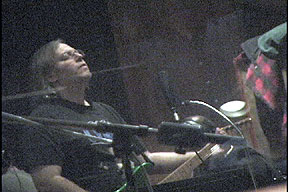 The first part of this was always intended to be a tribute to The Who. The epic unofficial 6-CD MK/BFD live set “Midwestern Bermuda Triangle Chronicle Vols. 1-6” (lovingly compiled by Dave Foster) contains thirteen minutes of me teaching the song to the band at a soundcheck prior to an SWR clinic in Omaha – the selection is entitled “Uncle Tommy Rehearsal.” Jason, especially, took the Who tribute aspect of this song to heart in his performance. He went to great lengths to channel Keith Moon on this song.
The first part of this was always intended to be a tribute to The Who. The epic unofficial 6-CD MK/BFD live set “Midwestern Bermuda Triangle Chronicle Vols. 1-6” (lovingly compiled by Dave Foster) contains thirteen minutes of me teaching the song to the band at a soundcheck prior to an SWR clinic in Omaha – the selection is entitled “Uncle Tommy Rehearsal.” Jason, especially, took the Who tribute aspect of this song to heart in his performance. He went to great lengths to channel Keith Moon on this song.
As I recall it, the middle and ending sections of “Kedgeree” were written very quickly at a BFD rehearsal with everyone else in the band waiting for me to hurry up, because I wanted to play the song at the next gig (this must have been early ’99, just prior to the live debut of the six-piece BFD). I think these parts of the song benefited from being written very quickly – there was simply no time to think anything through too much. I can’t remember at what stage the title came into the picture, but I was very excited to find the word (in a seventies-era cookbook published by Sunset magazine I think) – although it’s got nothing to do with anything in the lyrics, the sound of the word felt right, and I knew it was the name of the song.
Bryan’s comments about this song in his “Talking About Dancing” piece capture the feeling of recording this song perfectly. How fortunate we were to get this song in one take! There’s little I can say about it really – perhaps there’s not much that I want to say about it. Every once in a while something happens in your life and you can only consider yourself fortunate to have been present – that’s the way I feel about this recording.
It fills me with pleasure to be able to present work such as this album to you. I’m deeply grateful to all the wonderful members of my band for playing so beautifully and for feeling the music as deeply as I did. Thanks as well to Scott Chatfield for countless reasons, to Mike Harris, Jeff Forrest, atticus wolrab, Bob Tedde, Mark DeCerbo, Peggy Totzke, Jesse Keneally and to everyone who’s mentioned in the liner notes. Making “Dancing” was a magical time. It’s not a perfect album by any means but it was the best I had in me. Considerations of how this album “stacks up” in comparison to other albums of mine are often interesting and fun to read but strike me as irrelevant in the whole. These albums are signposts on a journey and to those of you who’ve found it worth your while to join me, I offer my most profound gratitude.
All photos on this page are still frame captures from video shot by J Warner during the recording and mixing of “Dancing” in May and June, 2000.
Dancing With Myself…And Others
Mike Keneally & Beer For Dolphins
Released 2000
Initially included in the now-sold-out Dancing Special Edition, Dancing With Myself: Live and Acoustic at the Baked Potato features spirited solo piano and guitar versions of Dancing songs recorded in Hollywood in May, 2000, including “Lonely Man,” a new song never before released. And as this intimate, funny and fiercely cooking 73-minute set careens to a close, Mike is joined onstage by his BFD compadres.
Dancing With Myself: Live and Acoustic at The Baked Potato’s songs:
- I Was Not Ready for You
- Lonely Man
- Friends and Family
- Joe
- Live in Japan
- We’ll Be Right Back
- I Will
- Apple Pie
- Backwards Deb
- Ankle Bracelet
- Dancing
- Lhai Sal
- Pretty Enough for Girls
- Only Mondays
- Kedgeree
Releases:
Exowax / EX2404 / 2000 (cd)
Exowax / EX2404-1 / 2000 (cd SE – w/ Dancing With Myself cd)
Exowax / EX2404-1d / 2009 (download – Dancing With Myself)
The Mike Keneally Discography
The Thing That Knowledge Can’t Eat | Scambot 2 | Inkling | Dancing Demos | Live At Mama Kin | You Must Be This Tall | Mike Keneally Free EP Volume 1 | Mike Keneally Free EP Volume 2 | Wing Beat Elastic-Remixes, Demos and Unheard Music | Wing Beat Fantastic: Songs Written by Mike Keneally & Andy Partridge | bakin’ @ the potato! | Evidence of Humanity | Elements Of A Manatee | Scambot 1 | Songs and Stories Inspired By Scambot 1 | The Scambot Holiday Special | Wine and Pickles | Guitar Therapy Live | Dog | Pup | Vai Piano Reductions Vol.1 | The Universe Will Provide | Parallel Universe | Wooden Smoke | Wooden Smoke Asleep | Dancing | Dancing With Myself… And Others | Nonkertompf | Nonkertalk | The Tar Tapes Vol.2 | Sluggo! | The Tar Tapes Vol.1 | Half Alive in Hollywood | Soap Scum Remover | The Mistakes | Boil That Dust Speck | hat. | Tar Tapes Vol.5 – Your Way Bitchin’ Bonus Tape | Tar Tapes Vol.4 – Drop Control | Tar Tapes Vol.3 – Fashion Poisoning | Tar Tapes Vol.2 – Life’s a Butter Dream/Elephants Walking Under God | Tar Tapes Vol.1 – The Wow Sound of Affable Mort


